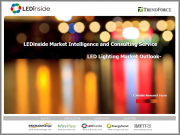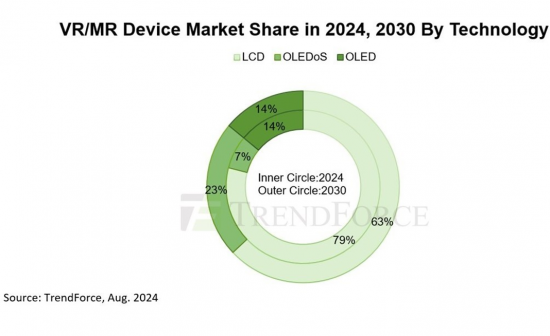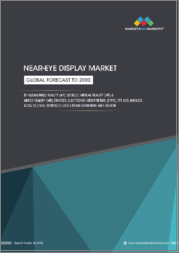
|
시장보고서
상품코드
1527363
세계의 TrendForce(2024년) : 근안 디스플레이 시장 동향과 기술 분석TrendForce 2024 Near-Eye Display Market Trend and Technology Analysis |
||||||
TrendForce: VR/MR 디바이스의 출하 대수는 2030년까지 3,700만대에 도달해 OLEDoS와 LCD가 하이엔드 및 주류 시장을 독점할 전망입니다.
TrendForce의 최신 보고서에 따르면 근안 디스플레이(NED)의 출하량은 재고 소멸과 함께 향후 몇 년동안 매년 증가할 것으로 예상됩니다. 하이엔드의 VR/MR 시장에서는 OLEDoS의 기술 점유율이 2030년까지 23%로 상승하고, 주류 시장에서는 LCD가 계속해서 근안 디스플레이의 63%의 점유율을 차지할 것으로 예측되고 있습니다.
TrendForce에서는 VR/MR 디바이스를 하나의 디스플레이로 몰입감을 실현하는 장치를 근안 디스플레이(Near-Eye Display)로 정의하고 있습니다. 투명성을 중시하고 가상과 현실의 활용 영역을 통합한 디바이스는 AR 디바이스로 분류됩니다.
TrendForce는 VR/MR은 이미 엔터테인먼트와 게임 분야에서 확고한 기반을 확립하고 있다고 지적합니다. 게다가 2024년 Apple Vision Pro의 도입은 VR/MR의 용도에 새로운 길을 열 것으로 기대되고 있습니다. 현재 문제가 되는 고가의 가격 및 제한된 서비스 컨텐츠는 시간이 지남에 따라 개선될 것으로 예상됩니다. 따라서 TrendForce에서는 VR/MR 디바이스의 출하 대수는 2030년까지 3,730만대에 달하고, 2023년부터 2030년까지의 복합 연간 성장률(CAGR)은 23%를 나타낼 것으로 예측했습니다.

제조업체의 전략이 VR/MR 시장에서 OLEDoS 보급을 촉진
Apple Vision Pro에 대한 Sony와 Apple의 제휴는 하이엔드 VR/MR 시장에서 OLEDoS의 이점을 확립했습니다. 이 제휴는 업계가 고해상도의 VR/MR 기기를 추구하고 있음을 부각시켜 OLEDoS에 대한 주목을 높였습니다.
OLEDoS는 CMOS와 고발광 OLED 컴포넌트를 채용하여 높은 발광 효율을 실현하여 OLEDoS 제품의 기본 해상도를 3,000 PPI 이상으로 밀어 올렸습니다. TrendForce는 CMOS 제조의 복잡성과 수율이 낮기 때문에 OLEDoS 디스플레이의 제조 비용이 높아지고 확산의 성장을 억제하고 있다고 지적했습니다.
TrendForce는 또한 OLEDoS 분야에 적극적으로 투자하고 있는 외자계 기업 외에도 SeeYa와 BOE 등 중국 업체들도 추종하고 있다고 지적했습니다. 이에 따라 VR/MR 디바이스 시장에서 이 기술의 향후 확대가 촉진되어 CMOS 기술의 비용 절감과 수율 향상에 기여할 것으로 기대됩니다. OLEDoS는 하이엔드 시장에서도 여전히 가능성을 가지고 있으며 TrendForce는 시장 점유율이 2024년 7%에서 2030년 23%로 확대될 것으로 예측했습니다.
개발 자원 투자 및 디스플레이 사양 반복으로 LCD 경쟁력 강화
주류의 근안 디스플레이 시장에서는 Meta가 비용 효과를 중시하고 있기 때문에 LCD 기술이 우위를 유지하고 있습니다. 그러나 고화질화 및 고화질화가 진행됨에 따라 1,200PPI의 LCD 제품은 다른 기술과의 경쟁에 직면하게 됩니다. TrendForce의 예측에서 2024년 LCD 근안 디스플레이 제품의 출하 대수는 680만대로 2023년 대비 5.6% 감소합니다.
TrendForce는 LCD의 복잡한 부품에는 여전히 최적화의 여지가 있다고 지적합니다. 예를 들어, 현기증을 줄이기 위한 액정 재료의 개선, 1,500 PPI를 넘는 해상도를 높이기 위한 백플레인 기술의 갱신 등입니다. BOE는 VR/MR 기기에서 LCD 디스플레이 사양의 지속적인 업데이트와 반복을 통해 근안 디스플레이에서 LCD 응용에 상당한 투자를 하고 있으며, 이 기술이 중저가 시장에서 강력한 경쟁력을 유지 보장합니다. TrendForce는 LCD 기술이 2030년까지 63% 시장 점유율을 차지할 것으로 예측됩니다.
OLED 시장 점유율은 13-15%에 그칩니다.
발광 재료는 증착 후 스크린을 완전히 덮을 수 없기 때문에 VR/MR 기기 사용 시 스크린 도어 효과를 악화시킵니다. TrendForce에 따르면 OLED는 하이 엔드 시장에서 OLEDoS보다 경쟁력이 떨어지며 LCD 제품의 비용 효율성에 미치지 못합니다. 게다가 VR/MR 시장에서의 OLED의 적용은 특정 제조업체에 크게 의존하고 있어 보급률이 장기적으로 제한되고 있습니다. TrendForce는 2024년부터 2030년까지 VR/MR 시장의 OLED 시장 점유율은 13-15%에 그칠 것으로 예측했습니다.
목차
제1장 근안 디스플레이 개발 개요
- AR/VR/MR의 탄생
- 현실에서 가상으로: 가상 이미지와 현실 이미지의 연속 스펙트럼
- 마케팅에서 MR의 두 가지 주요 의미
- XR 체험을 만들기 위한 기술 아키텍처
- 성배 : MR의 "고래의 순간"
- AR/VR/MR의 사양 분석
- AR/VR/MR의 디스플레이 기술의 로드맵
- AR/VR/MR 시장의 과제 : 고수준의 PPI
- 눈의 최고 해상도는 중심부에 한정된다 : 망막에서 중심 와우까지
- 포비에이티드 디스플레이: 픽셀의 효율적인 재분배
- AR/VR/MR 디스플레이의 과제 : 혼잡 조절 경쟁(VAC)
- VR/MR 디바이스 디스플레이 솔루션 개발
- VR/MR의 주요 지표 : 해결의 「제어 불능」요건
- VR/MR의 딜레마: PPD/두께와 소비 전력의 트레이드 오프
- VR/MR 광학 기술의 중요한 지표 : 두께
- VR/MR 광학 기술의 주요 지표 : FOV
- VR/MR의 딜레마: 디스플레이 저항을 억제하기 위해 MPRT를 축소
- 팬케이크 광학은 VR/MR 기술에 필수가 된다
- 팬케이크 2.0: 광학 기술의 하이라이트
- 팬케이크 2.0 : 한층 더 두께가 얇아졌습니다
- 팬케이크 2.0: 효율성이 더욱 향상
- VR/MR 광학 시스템의 정세
- VR/MR 디스플레이 : LCD와 OLED
- VR/MR을 둘러싼 PPD 경쟁: 디스플레이에서 시스템까지 확대
- VST 디스플레이 지연 문제
- 디스플레이 사양을 VR/MR 요건에 맞춘다
- AR시장의 과제 : 결코 너무 작을 것은 없습니다
- AR시장의 과제 : 결코 밝지 않은
- 광학 시스템의 경향
- 라이트 엔진과 광학 시스템
- 광학 분석의 상황
- 디스플레이 사양과 AR 요건의 정합
- 증강현실(AR) 디스플레이 기술 매트릭스
제2장 근안 디스플레이 시장 동향 분석
- NED 시장 규모 분석(2024년-2028년)
- VR/MR 시장 규모 분석(2024년-2028년)
- AR 시장 규모 분석(2024년-2028년)
- VR/MR 시장 규모 분석 : LCD/OLEDoS(2024-2028년)
- AR 시장 규모 분석 : OLEDoS/LEDoS(2024-2028년)
제3장 근안 디스플레이 기술의 개요
3.1 OLEDoS
- OLEDoS의 기본 프로세스
- OLEDoS 기술의 상황
- OLEDoS: PPI와 밝기의 추가 향상
- OLEDoS 분석 : Sony/eMagin/Kopin/RAONTECH
- 고해상도 OLEDoS의 대안으로서의 Al 애노드 프로세스
- Al 애노드의 채용에 의해 OLEDoS 업계의 분업이 변화할 가능성
- 투명한 OLEDOS: OLED-on-SOI
- OLEDoS : 2024년에 AR에서 VR/MR로 이행
3.2 LEDoS
- 증강현실(AR) : LEDoS 제조 공정
- LEDoS 기술의 포트폴리오 로드맵
- LEDoS의 기기 및 제조 공정의 갱신
- 에피택시: 기판 재료와 사이즈 옵션
- 칩 : 2D/3D구조 해석
- 칩 제조 및 백엔드 칩 제조 공정
- ALD의 패시베이션
- 접합 : 온도,압력,정밀도가 중요한 기술적 요소
- 접합 : CTE의 불일치
- 접합 : 사이즈의 불일치의 문제
- 비전통적인 접합: LED+단일 기판 공정
- LED 광원의 본질적인 한계: 광 집중의 과제
- 온칩 광학: 마이크로 광학이 새로운 초점
- 풀 컬러 마이크로 디스플레이 기술
- InGaN 적색광 기술
- 적색광의 딜레마 : InGaN인가 AlInGaP인가? ALD 패시베이션
- InGaN 적색 LED: 아직 개발 중
- 풀 컬러 디스플레이 : QD 컬러 변환의 장점, 단점 분석
- 풀 컬러화: NRET 메커니즘에 의해 QDCC가 더욱 진화
- 최대 3,000PPI의 고해상도가 가능한 QDCC
- 풀 컬러 디스플레이: RGB 수직 스태킹
- 수직 스태킹 LEDoS 기술
- 수직 스태킹 LEDoS 기술의 과제
- 수직 스태킹 LEDoS 기술의 장점
- 수직 적층형 LED PKG:디스플레이용 상용 용도
- LEDoS 소형화의 다음의 「전장」 : QDCC 대 수직 스태킹
- 풀 컬러화: 복수/단색의 조정 가능한 LED
- 와이어/로드 LEDoS : 고수준 PPI용 용도에 있어서의 효율의 우위성
- NED용 LEDoS 기술 평가
- 와이어/로드 LEDoS: 장단점
- LEDoS 마이크로 디스플레이의 주요 기술 분석
3.3 LCD
- 주요 LCD 기술 : 컬러 순차
- LCD의 주요 기술 : 미니 LED 백라이트
- LCD(유리상) PPI의 돌파구
- LCD(유리상) 높은 프레임 레이트
- LCD 백라이트 혁명:레이저
- LCD 백라이트 혁명:레이저+HOE
- LCD 기술 개발 개요 : LCD의 잠재능력 완전해방
- LCD는 VR/MR로 경쟁력을 유지: 풍부한 「무기고」
3.4 LCoS
- LCOS : 광 엔진의 소형화
- LCOS : 디스플레이 모듈의 사이즈가 0.47cc로 축소
3.5 DLP
- DLP의 추가 진화: TRP(Tilt-and-Roll Pixel) 기술
3.6 LBS
- LBS : 에코시스템과 광엔진의 소형화
- 레이저 빔 스캔(LBS) : 사이즈/해상도
3.7 OLED
- OLED와 다른 기술과의 선순환
- OLED 드라이버 회로의 수직 스태킹: OLED-on-OS-on-Si
제4장 업계 레이아웃과 기업 동향 : 최신 상황
- XR 기업의 LEDoS용 기업 합병,인수(M&A) 전략 개요
- Google의 M&A 전략(JDC/Raxium)
- Meta의 M&A 전략(InfiniLED/MLED)
- Apple의 M&A 전략(Luxvue/Tesoro)
- Porotech
- JBD
- Sitan
- Raysolve
- Saphlux
- Mojo Vision
- Ostendo
- LG OLEDoS의 연혁(2021년-2024년)
- 기업용 하이엔드 MR 시장 진입을 위한 t협력
- Apple Vision Pro의 디스플레이와 광학
- Apple Vision Pro의 스필오버 효과
- 소비자 시장용 생산성 툴로서의 Apple Vision Pro
- LCD와 OLED의 마이크로 디스플레이 전투: Quest 3 대 Vision Pro
TrendForce: VR/MR Device Shipments to Reach 37 Million Units by 2030, with OLEDoS and LCD Dominating High-End and Mainstream Markets
TrendForce's latest report reveals that shipments of near-eye displays are expected to increase year-by-year over the next few years following inventory clearance. It is anticipated that OLEDoS will dominate the high-end VR/MR market, with its technological share rising to 23% by 2030, while LCD will continue to occupy the mainstream market, holding a 63% share in near-eye displays.
TrendForce defines VR/MR devices as near-eye displays that achieve an immersive experience through a single display. Devices emphasizing transparency and the integration of virtual and real-world applications are classified as AR devices.
TrendForce notes that VR/MR has already established a solid foundation in the entertainment and gaming sectors. Furthermore, the introduction of Apple Vision Pro in 2024 is expected to open new avenues for VR/MR applications. Current issues of high pricing and limited service content are expected to improve over time. Therefore, TrendForce predicts that VR/MR device shipments could reach 37.3 million units by 2030, with a CAGR of 23% from 2023 to 2030.

Manufacturers' strategies drive OLEDoS penetration in the VR/MR market
The collaboration between Sony and Apple on the Apple Vision Pro has established OLEDoS as dominant in the high-end VR/MR market. This partnership highlights the industry's pursuit of high-resolution VR/MR devices and has increased attention on OLEDoS.
OLEDoS employs CMOS and top-emitting OLED components to achieve higher luminous efficiency, pushing the basic resolution of OLEDoS products to over 3,000 PPI. TrendForce notes that the complexity of CMOS manufacturing and its lower yield rates result in high production costs for OLEDoS displays, which limit its penetration growth.
TrendForce also indicates that, in addition to international companies actively investing in the OLEDoS field, Chinese manufacturers such as SeeYa and BOE are also following suit. This is expected to drive the future expansion of this technology in the VR/MR device market, helping to reduce costs and improve yield for CMOS technology. OLEDoS still has potential in the high-end market, with TrendForce estimating its market share will increase from 7% in 2024 to 23% in 2030.
Investment in development resources and iteration of display specifications strengthen LCD competitiveness
In the mainstream near-eye display market, LCD technology remains dominant due to Meta's focus on cost-effectiveness. However, as these devices continue to pursue higher resolution and image quality, LCD products-with their 1,200 PPI-will face competition from other technologies. TrendForce estimates that in 2024, the shipment volume of LCD near-eye display products will be 6.8 million units, a 5.6% decrease compared to 2023.
TrendForce points out that there is still room for optimization in the complex components of LCD. For example, improving liquid crystal materials to reduce dizziness and upgrading backplane technology to boost resolution beyond 1,500 PPI. BOE has invested heavily in the application of LCD in near-eye displays, with continuous updates and iterations of LCD display specifications in VR/MR devices, ensuring this technology maintains strong competitiveness in the mid-to-low-end market. TrendForce forecasts that LCD technology will hold a 63% market share by 2030.
OLED market share to remain between 13% and 15%
Emission material cannot fully cover the screen after deposition, which exacerbates the screen door effect when using VR/MR devices. TrendForce indicates that OLED is less competitive than OLEDoS in the high-end market and cannot match the cost-effectiveness of LCD products. Additionally, the application of OLED in the VR/MR market relies heavily on specific manufacturers, limiting its long-term penetration rate. TrendForce estimates that from 2024 to 2030, the market share of OLED in the VR/MR market will remain between 13% and 15%.
Table of Contents
Chapter I. Near-Eye Display Development Overview
- The Birth of AR / VR / MR
- From Reality to Virtuality: The Continuous Spectrum of Virtual and Real Images
- Two Major Meanings of MR in Marketing
- Technical Architecture for Creating XR Experiences
- Holy Grail: "The Whale Moment" of MR
- AR / VR / MR Specification Analysis
- AR / VR / MR Display Technology Roadmap
- AR / VR / MR Market Challenges: High PPI
- Highest Resolution for Eyes is Limited to the Central Area:From the Retina to Fovea
- Foveated Display: Efficient Redistribution of Pixels
- AR / VR / MR Display Challenges: Vergence Accommodation Conflict (VAC)
- Development of VR / MR Device Display Solutions
- Key Indicators for VR / MR : The "Out of Control" Requirements of Resolution
- VR / MR Dilemma: Trade Off between PPD/Thickness and Power Consumption
- Key Indicators for VR / MR Optical Technology: Thickness
- Key Indicators for VR / MR Optical Technology: FOV
- VR / MR Dilemma: Reduced MPRT to Suppress Display Drag
- Pancake Optics Becomes a Must for VR / MR Technology
- Pancake 2.0: Highlights of the Optical Technology
- Pancake 2.0: Thickness Is Further Decreased
- Pancake 2.0: Efficiency Is Further Increased
- VR / MR Optic System Landscape
- VR / MR Displays: LCD vs. OLED
- PPD Competitions for VR / MR Extend from Displays to Systems
- Latency Issues of VST Displays
- Aligning Display Specifications with VR / MR Requirements
- AR Market Challenges- Never Too Small
- AR Market Challenges- Never Too Bright
- Optical System Trend
- Light Engine vs. Optical System
- Optical Analysis Landscape
- Aligning Display Specifications with AR Requirements
- Augmented Reality Display Technology Matrix
Chapter II. Near-Eye Display Market Trend Analysis
- 2024-2028 NED Market Size Analysis
- 2024-2028 VR / MR Market Size Analysis
- 2024-2028 AR Market Size Analysis
- 2024-2028 VR / MR Market Size Analysis :LCD/OLEDoS
- 2024-2028 AR Market Size Analysis :OLEDoS/LEDoS
Chapter III. Near-Eye Display Technology Overview
3.1 OLEDoS
- OLEDoS Basic Process
- OLEDoS Technology Landscape
- OLEDoS: Further Increases in PPI and Brightness
- OLEDoS Analysis: Sony / eMagin / Kopin / RAONTECH
- Al Anode Process as an Alternative to High-Resolution OLEDoS
- Adopting Al Anode May Change Division of Labor in OLEDoS Industry
- Transparent OLEDoS: OLED-on-SOI
- OLEDoS Shifts from AR to VR / MR in 2024
3.2 LEDoS
- Augmented Reality: LEDoS Manufacturing Process
- LEDoS Technology Portfolio Roadmap
- LEDoS Equipment and Manufacturing Process Upgrades
- Epitaxy: Substrate Materials and Size Options
- Chip: 2D / 3D Structural Analysis
- Chipmaking and Back-end Chipmaking Processes
- ALD Passivation
- Bonding: Temperature, Stress, and Precision are Key Technical Factors
- Bonding: CTE Mismatch
- Bonding: Size Mismatch Problem
- Non-conventional Bonding: LED + Single-substrate Process
- Intrinsic Limitations of LED Light Sources: Light Concentration Challenge
- On-chip Optics: Micro-optics is a New Focus
- Full Color Microdisplay Technologies
- InGaN Red Light Technology
- Red Light Dilemma: InGaN or AlInGaP?ALD Passivation
- InGaN Red LEDoS Are Still Under Development
- Full Color Display: QD Color Conversion Pros and Cons Analysis
- Full-colorization: QDCC To Be Further Advanced by NRET Mechanism
- QDCC Capable of High Resolution Up to 3,000 PPI
- Full Color Display: RGB Vertical Stacking
- Vertical Stacking LEDoS Technology
- Vertical Stacking LEDoS Technology Challenges
- Advantages of Vertical-stacking LEDoS Technology
- Vertically Stacked LED PKG: Commercial Application Aiming at Displays
- Next "Battlefield" for LEDoS Miniaturization: QDCC vs. Vertical Stacking
- Full-colorization: Multiple or One Color Tunable LED
- Wire/Rod LEDoS: An Edge in Efficiency for High PPI Applications
- LEDoS Technology Evaluation for NED
- Wire/Rod LEDoS: Pros and Cons
- LEDoS Microdisplay Key Technology Analysis
3.3 LCD
- Key LCD Technology: Color Sequential
- LCD Key Technology: Mini LED Backlight
- LCD (on Glass) PPI Breakthrough
- LCD (on Glass) High Frame Rate
- LCD Backlight Revolution: Laser
- LCD Backlight Revolution: Laser + HOE
- LCD Technological Development Summary: LCD Potential Fully Release
- LCD Maintain Competitiveness in VR / MR: The Abundant "Arsenal"
3.4 LCoS
- LCOS: Light Engine Miniaturization
- LCOS: Display Module Size Shrinks to 0.47cc
3.5 DLP
- DLP Further Advancement: Tilt-and-Roll Pixel (TRP) Technology
3.6 LBS
- LBS: Ecosystem and Light Engine Miniaturization
- Laser Beam Scanning: Size / Resolution
3.7 OLED
- Positive Cycle Between OLED and Other Technologies
- Vertical Stacking of OLED Driver Circuits: OLED-on-OS-on-Si
Chapter IV. Industry Layout and Player Dynamic Updates
- XR Companies M&A Strategies Overview for LEDoS
- Google M&A Strategies (JDC/Raxium)
- Meta M&A Strategies (InfiniLED/MLED)
- Apple M&A Strategies (Luxvue/Tesoro)
- Porotech
- JBD
- Sitan
- Raysolve
- Saphlux
- Mojo Vision
- Ostendo
- LG OLEDoS Advancement History (2021-2024)
- Collaborate to Enter the High-end MR Competition in Businesses
- Apple Vision Pro Display and Optic
- Apple Vision Pro Spillover Effect
- Apple Vision Pro as a Productivity Tool for Consumer Market
- Microdisplay Battle between LCD and OLED: Quest 3 vs. Vision Pro















